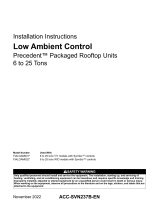
18-HH40D1-1A-EN
Defrost Coil Sensor Kit
KIT19795
(Used on all HP models except Side Discharge models)
Installer’s Guide
Safety Considerations
HAZARDOUS VOLTAGE!
Failure to follow this Warning could result in property
damage, severe personal injury, or death.
Disconnect all electric power, including remote
disconnects before servicing. Follow proper lockout/
tagout procedures to ensure the power cannot be
inadvertently energized.
Only qualified personnel should install and service the
equipment. The installation, starting up, and servicing
of heating, ventilating, and air-conditioning equipment
can be hazardous and requires specific knowledge
and training. Improperly installed, adjusted or altered
equipment by an unqualified person could result
in death or serious injury. When working on the
equipment, observe all precautions in the literature
and on the tags, stickers, and labels that are attached
to the equipment.
ALL phases of this installation must comply with NATIONAL, STATE AND LOCAL CODES
IMPORTANT — This Document is customer property and is to remain with this unit. Please return to service information
pack upon completion of work.
Inspection
1. Unpack all components of the kit.
2. Check carefully for any shipping damage. If any
damage is found, this must be reported immediately
and a claim made against the transportation
company.
3. Check to be sure all components are in the package.
Any missing components should be reported to
your supplier at once and replaced with authorized
components only.
Installation:
1. To remove the clip, firmly hold sensor base with both
hands. Firmly press with both thumbs on the open
end of the clip and push towards the sensor bulb.
2. To replace with the 3/8 clip, line up the clip notches to
the sensor base and follow steps in reverse.
Use the steps in the troubleshooting flowchart on the next
page to identify the new placement of the coil sensor.
General Information
It is normal to have variations in feeding of the outdoor
refrigerant circuits. In some applications it is normal to
see this in the form of frost banding. The recommended
solution in these situations is to relocate the coil sensor
to another circuit.
Before relocating the coil sensor, verify the following:
• refrigerant charge
• indoor air performance and
• air circulation around the outdoor unit
Steps in this document will aid in the identification of which
circuit might be best in the relocation of the coil sensor.
Coil Sensor Kit Contents:
Item Qty. Description
1 1 3/8” Coil Clip
2 1 Installer’s Guide


